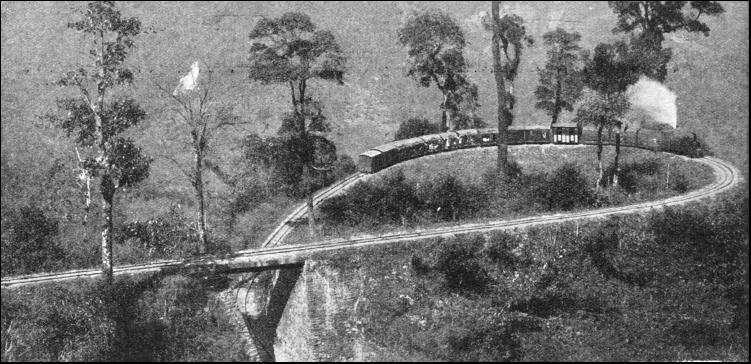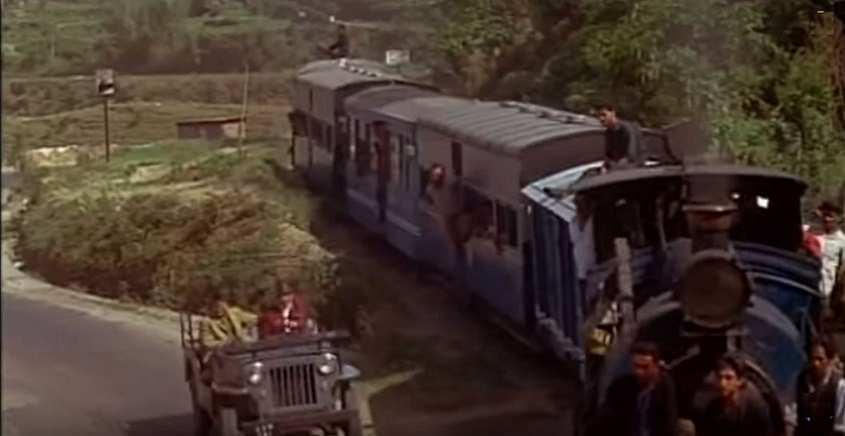Darjeeling Himalayan Railway
This is a collection of articles archived for the excellence of their content. Readers will be able to edit existing articles and post new articles directly |
History
The settlement at Darjeeling really began in 1828 with British interest. By 1835, it was separated from Sikkim for establishing a Sanatorium for the invalid servants of the East India Company. It then consisted of a monastery on observatory hill clustered with about 20 huts and a population of about 100 people. Planning began in 1839, to lay out the Darjeeling Town and construct a hill road connecting Siliguri, Pankhabari, Kurseong and Darjeeling. At the same time, evolution of hotels began, the first being The Darjeeling Family Hotel's, followed by other hotels. By 1840, Darjeeling Town had about 30 buildings and a few respectable houses. Tea bushes were brought in by the British from China and Tea plantations began spreading rapidly from 1857. To meet the expanding requirements, a new road fit for carts was planned in 1861. Subsequently, in 1879, the Darjeeling Himalayan Railway was constructed on the same hill cart road.

The Darjeeling Himalayan Railway is the first, and still the most outstanding example of a hill passenger Railway. Open in 1881, it applied bold and ingenious engineering solutions to the problem of establishing and effect rail link across a mountainous terrain of great beauty. It is still fully operational and retains most of its original features intact. While Darjeeling was growing, Rowland Macdonald Stephenson was crusading his battle for railway extension in India. In 1849, he was able to extract favourable conditions including a guarantee of return on the capital. He promoted East Indian Railway Co. (EIR).
In 1858, Eastern Bengal Railway (EBR), a private company got concession for construction and management of Railway lines commencing from the left bank of Hooghly towards the Eastern and Northern part of Bengal, including a line to Darjeeling, but the directors were not willing to invest money in extensions including the one to Darjeeling as that might not be profitable. However, NBR(Northern Bengal State Railway) had no plan to take the rails to the hills, mainly because the hills were considered a formidable sphere. Where EBR and NBR failed as corporate organizations, Prestage succeeded, as an individual entrepreneur.
The Franklin Prestage, the agent of guaranteed Eastern Bengal Railway was fascinated by the ethereal views of Kanchenjunga floating in the mists of Darjeeling. When he took up the agent ship of EBR, the state owned Northern Bengal Railway was in advanced stage of construction of a line to Siliguri.
Franklin Prestage settled for a 2ft. rail gauge, and formed the Darjeeling Steam Tramway Co. with capital fully subscribed in India. On September 15, 1881, title of the company was changed to Darjeeling Himalayan Railway Co. and this company remained effective until the line was taken over by the Indian Government on Oct.20, 1948. All through that time the line was managed by the agency of ‘Gillanders Arbuthnot and Co.’ which supervised from its Calcutta office the financial, legal and purchasing interests of DHR and of other small railways. A manager and engineer were stationed at Kurseong, while the mechanical superintendent was at Tindharia.
The Darjeeling line was built to a gauge of 2 feet (600mm) to enable the line to traverse the tightly twisting route through the hills. In 1886, though, the well tanks and under cylinder wings were retained, a narrow saddle tank was inserted between the dome and the chimney, partly to get increased water capacity and partly to get better balance between the axle loads with the pull on the draw bar. Regarding the Official opening date of Darjeeling Himalayan Railway (DHR) are, from Siliguri to Kurseong is 23-08-1880, from Kurseong to Sonada 01-08-1881, Sonada to Jorebunglow 05-04-1881, Jorebunglow to Darjeeling 04-07-1881 and from Darjeeling to Darjeeling Bazar is 16-06-1886. Usually the construction stage, light engines are worked on the section much before the official date of opening.
The Ghoom Station is the highest point reached by the railway (7,407ft), and from here there is a descent for four miles down a spur to Darjeeling Station (6,812ft). Loops are the speciality of Darjeeling Himalayan Railway it helps in gaining height for the rail line skiting along the mountain with the radius of curve as minimum as possible. Loop No. 3 at Chunbhati km 23/14 between Rangtong and Chunbhati station is popularly known as Loop No.2 and technically it is the first loop now. This loop is double circle. Loop at Agony Point km.32 was between Tindharia and Gayabari stations existed and is popularly known as Loop no.3, though it is the second loop. The last loop near Batasia, popularly known as “Batasia Loop” is km.75/1. This loop is the most beautiful loop out of the existing loops. There are 132 unmanned level crossings in the route.
Darjeeling Himalayan Railway Extensions Company was authorized to construct a line from Panchanai to Kishanganj in the plains and another line to Kalimpong in the Sivok Mountains. These two sections are known as Kishjanganj Branch and Teesta Valley Branch respectively. Though no more connected by rail, Kalimpong could be reached by railway line from 1915 to 1951. These line was abandoned, a large sections of it were washed away after severe flood damaged in 1951.
Most of the steam engines in these days have been replaced by diesel electric or electric traction. Some narrow gauge lines still feature the old "iron horses".
DHR is a work of genius and technological achievement of 1881. It has social and cultural importance. It is beautiful and has out-standing universal appeal. As one of the outcomes of the Industrial revolution and based on its unique features, it is considered to be of lasting significance to mankind. It must be saved for posterity. These are all the criteria necessary for World Heritage.
National Rail Museum (India), the focus of India’s Rail heritage, submitted a proposal to UNESCO on 29th June 1998 for inscribing the Darjeeling Himalayan Railway (DHR) as a World HERITAGE Site. Accordingly, UNESCO’S World Heritage Committee inscribed DHR as a World Heritage Site on 2nd December 1999. The DHR has popularly known by the name as ‘Toy Train’ which is in fact was never an official term it is just a popular expression found in literature.
Imaarat:A toot from the past
By GM Kapur Apr 18 2014 Financial Chronicle
Darjeeling Himalayan Railway is an engineering marvel that tackled mountainous terrain with ingenious solutions
The sensation was pleasurable — intensely so; it was sudden and immense exaltation, a mixed ecstasy of deadly fright and unimaginable joy. I believe that this combination made the perfection of human delight. This is the most enjoyable day I have spent on the ea¬rth. It has no fault, no bl¬emish, no lack, except that there are only 35 miles of it instead of 500” —thus de¬scribed Mark Twain after being on the Darjeeling Him¬al¬ayan Railway (DHR) mo¬re than a 100 years ago.
The first — and still — the most outstanding ex¬ample of a hill passenger railway, DHR opened in 1881 connecting Siliguri in the foothills of the Hi¬malayan range in the north east with Darjeeling, climbing more than 2,000 metres in the mountainous region in the process. It was a marvel of engineering as it applied bold and ingenious solutions to the problem of establishing an effective rail link across this terrain of great beauty. It is a tribute to the builders that it is still fully operational and re¬tains most of its original features intact.
DHR has its origins in the latter part of the 19th century. Darjeeling (or Dorje-Ling, place of Lama Dorje, as is was originally called) had been developed by the British who had initially leased a strip to the south of the Himalayas from the rulers of the erstwhile kingdom of Sikkim, for a sanatorium for British troops as the climate was found to be salubrious.
Later this tract, including Darjeeling was annexed to the British Empire resulting in rapid progress to the region. By 1878, Calcutta, the capital of British India, was linked to Siliguri by rail. Till then, the only link between Siliguri and Darjeeling was a hill cart road used by either horse drawn carriages or bullock carts. As a result, the journey took almost five to six days. Tea cultivation had also developed and the need for suitable transportation was felt (as the existing horse drawn carriages and bullock carts were proving to be inadequate).
A detailed scheme for a steam tramway was submitted to the government of Bengal in 1878 and was approved in 1879 when construction also began. Between March 1880 and July 1881, the line was commissioned in stages. First to Tindharia, then to Kurseong and finally to Darjeeling. The rail link cut the journey time to less than 24 hours.
The total length of the DHR is 87.4 km, which is covered by a two feet (610 mm) gauge railway, rising from the plains at Siliguri to height of 2,258 m above sea level at Ghoom and finally reaching 2,074 m above sea level at Darjeeling. There are 456 bridges, (251 corbelled arch bridges) and 153 level crossings (all unmanned). There are 872 curves, maximum curvature being 120 degrees. The total length of line on curves is 59.4 km, The length of the line on curves of more than 60 degrees is 23.5 km.
To overcome natural obstacles, the line followed the hill cart road, avoided the necessity of big bridges, avoided tunnels, kept the investments low and maintained the steep gradient (1:25) by adhesion only.
Great ingenuity was shown in three ways: 1) zig-zagging and criss-crossing across the hill cart road; 2) running a loop where the train describes a full circle to finish at a similar spot some 20 feet higher; 3) reversing on a Z-shaped layout where the train runs forward, reverses up the slope, then proceeds forwards parallel to the approach line but at a higher altitude.
This made the construction of the DHR one of the greatest engineering feats of the 19th century. That it is still fully operational in the 21st century is an industrial heritage wonder of the world and now a Unesco designated heritage site since 1999.
(GM Kapur is convener of the West Bengal chapter of Intach)
UNESCO heritage site, stamp
Deep Gazmer and Roshan Gupta, August 26, 2021: The Times of India
The UN Educational, Scientific and Cultural Organization on Wednesday released a stamp on the heritage Darjeeling Himalayan Railway (DHR) that was declared a Unesco heritage site in 1999, report Deep Gazmer and Roshan Gupta.
“It is a moment of pride for Indian Railways as Unesco has launched a stamp on DHR. Among the few world heritage sites, DHR attracts tourists from all over the world,” the railways ministry tweeted.






